Author | Source
Severin Renold
Weissknight Corporate Finance

Severin Renold
Weissknight Corporate Finance
Content Marketing
Revenues for online businesses, publishers and/or websites are hugely dependent on advertising spending. But digital advertising can become quickly very expensive, while other methodologies can achieve the same purpose – selling more, like for example, “content marketing”.
What is content marketing?
In general, content marketing is a marketing technique that involves creating and spreading contents valuable from the point of view of recipients of the content, aimed at drawing attention and engaging a community gathered around a particular target group. Content is what users want to read, learn about, watch or experience. From the perspective of business, content is important information presented on a website, in an application, or by other available channels of digital presentation, which have the mission of communicating.
Nowadays, content marketing is not just a desirable thing; it’s a must-have. Moreover, it is necessary to create up-to-date content.

The world of media is changing rapidly, and long-term beliefs about value sources in a given business model, media segment, or geography are also evolving. Spending on media continues to shift from traditional to digital products and services. By the end of the year, experts believe digital spending will account for 60% of overall media spend. Digital, consisting of Internet- and mobile advertising, will become the largest advertising category in the coming years (surpassing TV), and mobile will more than double its share of the digital ad market.
In 2020 advertising spending continued to rise globally, with digital driving most of the growth with an increase of 17.6% YoY to $ 333 billion.
Specifically, in the US, digital ad spends will increase by 19.1% to $130 billion, while traditional advertising will fall 19% to $110 billion. That means digital will account for 54.2% of the total, while traditional will only represent 45.8%. The gap between digital and traditional will continue to widen, and by 2023 digital will account for more than two-thirds of total ad spending.
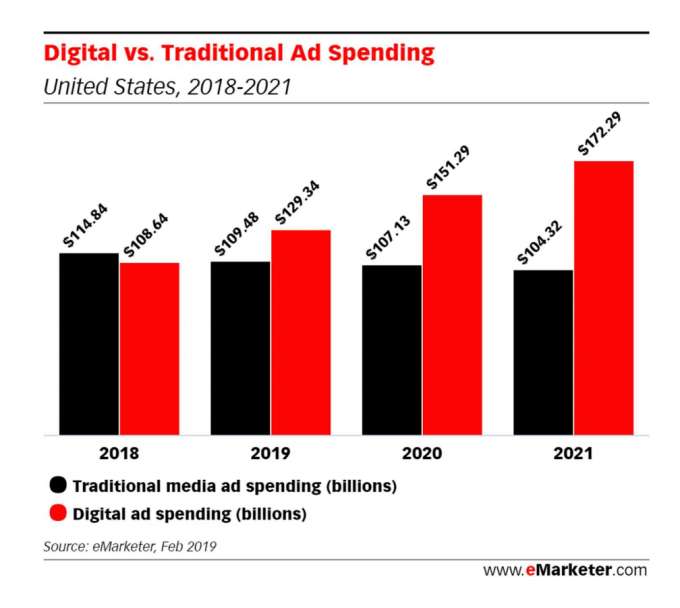
While digital ad spending will rise, data also shows two key trends:
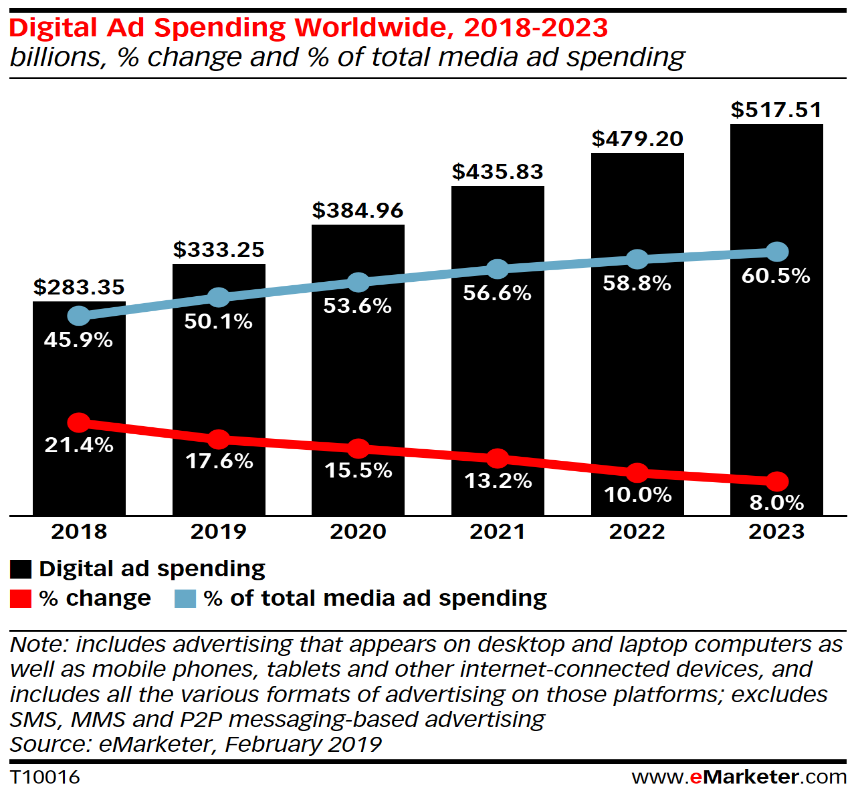
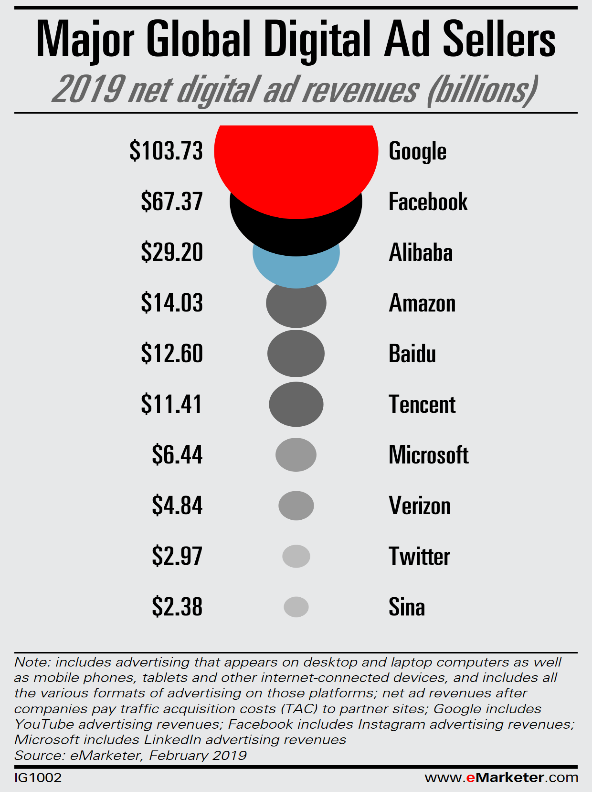
Google remained the most significant digital ad seller in the world in 2021, accounting for approx. 31.1% of worldwide ad spending ($103 billion). Facebook will be No. 2 ($67 billion), followed by China-based Alibaba ($29 billion). Google and Facebook alone commanded 90% of the growth in digital ad sales last year in the US. Amazon has been steadily chipping away at the Google-Facebook duopoly in the US, but it will be a smaller player on the global stage ($14 billion), although that still makes it the fourth-largest digital ad seller worldwide.
The Facebook-Google duopoly is even greater in the UK. Their combined share of the digital ad market will reach 63.3%, higher than their US share (59.3%).
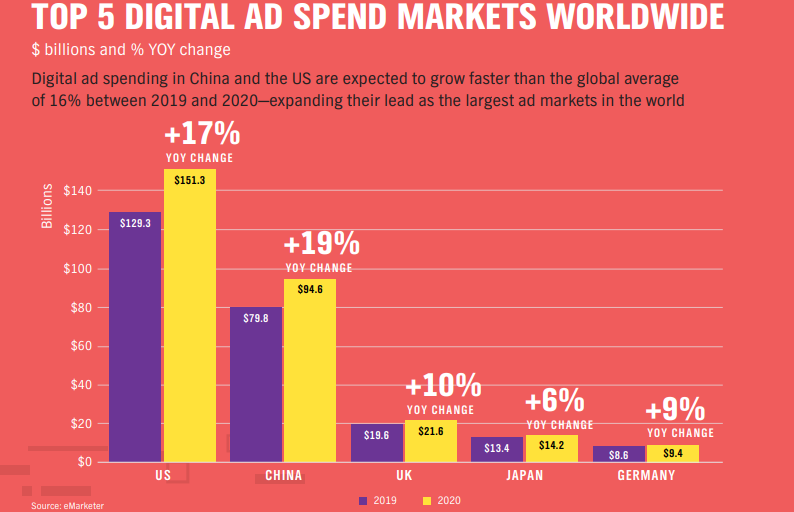
Conclusion:
The advertising industry is at a critical juncture in developing digital advertising technologies driven by the emergence of key technology platforms.
In 2019 retail e-commerce sales worldwide amounted to 3.4 trillion US dollars, and e-retail revenues are projected to grow to 4.8 trillion US dollars in 2021. Desktop PCs are still the most popular device for placing online shopping orders, but mobile devices, especially smartphones, are catching up.
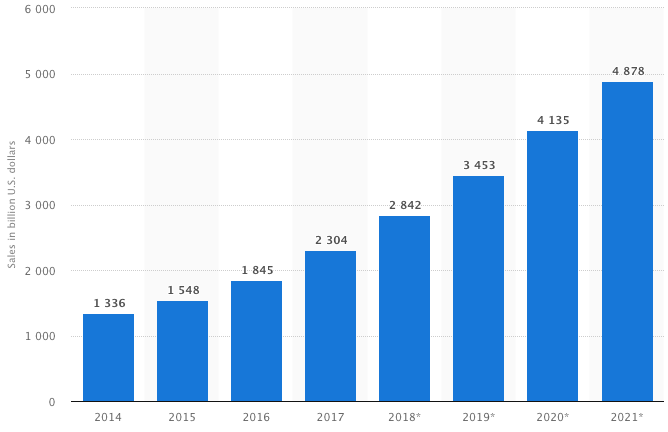
The confluence of new technologies, new entrants and new consumer demands has catapulted retail into a state of flux. These market shifts influence not only how shoppers choose to obtain their desired goods and services but also how and where they spend their money.
Consumers are increasingly turning to online and mobile channels to make purchases that they traditionally would have made at the cash wrap in years past. This deflection of spending has been fuelled, in part, by the rise of online marketplaces and the on-demand economy against the backdrop of new purchase experiences like click-and-collect and mobile order-ahead.
Looking ahead, businesses of all types – and especially those primarily operating in the brick & mortar realm today – must adopt the necessary strategies to meet their customers at the myriad digital touchpoints where they are increasingly looking to conduct commerce. With digital commerce growing more than six times the rate of in-store sales through 2022, it’s more than apparent that a well-executed digital transformation strategy will be a hallmark of long-term, sustainable growth in commerce.
Conclusion:
To increase their profit margins and extend their geographic presence, vendors are making investments in planning, designing, and developing new marketing techniques and acquiring new disruptive technology players. E-commerce is growing nearly 20% YoY and provides an opportunity for websites to capture part of this expanding revenue flow.
The double-digit YoY growth of e-commerce worldwide offers publishers a fantastic opportunity to create a new and stable revenue flow that goes beyond traditional advertising.

Innovation is a constant force driving the evolution of the digital media ecosystem. Digital channels are expected to provide nearly all incremental spend flowing into global marketing budgets through 2021.
Content marketing is a form of marketing that focuses on creating, publishing, and distributing content online for a target audience. It is often used by businesses to: Attract attention and generate potential customers to expand customer base generation or increase online sales. Increase brand awareness or credibility to attract online users. Community content marketing attracts potential customers by creating and sharing valuable free content. Turn potential customers into customers.
Content marketing has exploded in the last few years. According to analysts from Technavio, the industry is projected to be worth $ 413 billion by the end of 2021.

a. It’s a slow journey to see returns from content marketing. It takes months to gain traction, climb the search engine rankings, and begin building authority.
b. In the early days, lots of brands didn’t wait long enough to see the promised results. Others couldn’t see the value in content, mainly because adopters weren’t sure how to prove ROI.
c. However nowadays, the benefits start coming into focus. We can measure content marketing and point to concrete numbers that show exactly why it’s an excellent investment. As a result, more businesses are investing.
d. Proof of that can be seen, for example, in the global content marketing software market. From 2018 to 2023, it’s expected to enjoy a compound annual growth rate of 18.4%. It should surge from $ 4 billion in 2018 to $ 10 billion in 2023 (According to GlobeNewswire).
a. One of the main reasons content marketing is enjoying explosive growth is a simple fact: Modern consumers are using the Internet for almost everything, including news and information, entertainment, communication, education, shopping.
b. In particular, when it comes to shopping, today’s consumers aren’t limiting themselves to special purchases or certain types of goods. They’re buying everything you can think of, including consumer packaged goods like non-perishable grocery items, beauty products, and personal care products. According to a 2018 Periscope by McKinsey survey, 70% of respondents shop this way. Of course, their purchase decisions are affected by the Internet, too. Consumers now have the means to thoroughly research products, share their shopping experiences with a broad audience, and generally take more control over how and what they buy.
c. Combine these points with the fact that most online activity begins with a search, and you’ll start to see why content marketing fits in so neatly. Consumers are savvier than ever before, and their buying journeys are more complicated. They can smell a sleazy sales pitch from miles away. They know when brands are being genuine and when they’re just grabbing for money.
d. That’s why they respond so well to the non-sales approach of content marketing. Content provides value. Content answers questions and addresses pain points. Content builds trust and loyalty and creates customer-brand relationships.
e. The amazing part is brands are now seeing that meeting customers at the door of their search with valuable content works far better than trumpeting cold ads in their face. The cold ad approach is dying because customers are not responding the same ways they used to.
What are the trends:
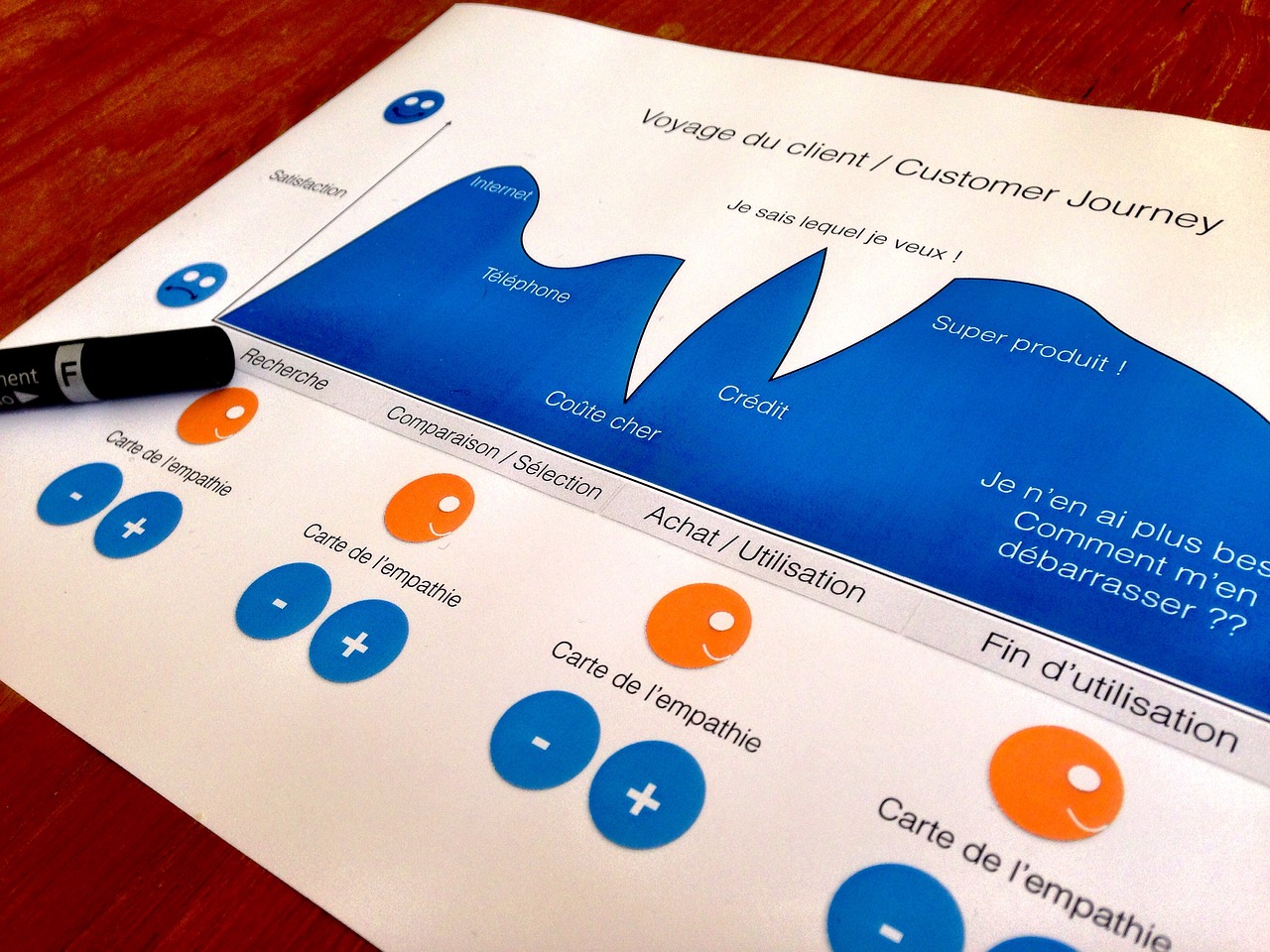
Content Marketing, “the most economical and effective”
The marketing specialist website The Drum recently collected some statements by Ujjwal Doshi, lead analyst at Technavio for media and entertainment: “Content marketing is the most economical and effective means of building brand awareness among consumers. If an audience can rely on a company for information, then they will most likely buy products from the same company. ”
According to this source, sponsored content has taken off as advertisers seek new ways to skirt ad blocking software while delivering tangential benefits in terms of improving search engine optimization, social media followings and PR.
80% of marketers outsource content
The latest Content Marketing Institute (CMI) report highlights that 59% of marketers expect their content marketing budget to increase this year, and eight out of ten marketing managers declare that they outsource content production. Not only can it make financial sense in the short term, but it drives greater long-term ROI by giving the people (and therefore Google) what they want.
Conclusion:
Digital Marketing is now mainstream. Digital Marketing Technology has emerged as one of the most exciting beneficiaries of recent advances in bandwidth, mobile computing, networking and cloud delivery technologies. From content creation to the actual ad impression, the Digital Marketing ecosystem is teeming with a vibrant community of participants, all involved in a rush to market ahead of their competitors and the more prominent established players. The acceleration in the growth of spending on digital media-based strategies has created attractive investment opportunities from startups through IPOs with significant M&A opportunities along the way.
The market for digital marketing remains one of the highest growth opportunities. The technology infrastructure and marketing expertise required to deliver this solution are significant in capability and sprawling in scope. Companies in all sectors, especially those with more competition on the Internet, are looking for alternative strategies that are more profitable in the long term and with greater customer engagement. Content marketing is gaining ground as one of the most effective ways to reach and retain customers without using aggressive sales tactics.
Among the growth factors of the sector will be:
1) The adoption of powerful content policies by businesses to generate engagement, personalization and generate interest.
2) The cost of Content Marketing is lower than traditional advertising in the long run.
3) Social media will continue to grow strongly in the coming years.
4) Consumers are migrating from conventional shopping channels to digital ones.